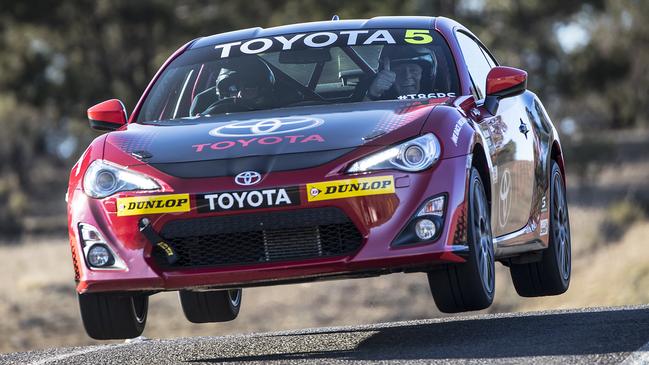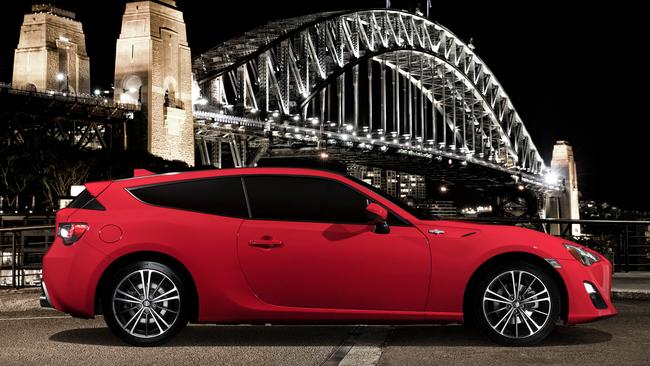Toyota 86 Race Series review: A giant leap
Toyota’s one-time Car of the Year is poised to make a track debut in one-make series.

New cars
Don't miss out on the headlines from New cars. Followed categories will be added to My News.
FLYING. Neal Bates is really flying as he shows what his Toyota 86 is capable of.
We’re slightly sideways at better than 140km/h, howling up past 200km/h, and braking deep and late in a car that has been tuned and tweaked — but not spoiled — to star in a new one-make motor racing series in Australia.
But the party trick is a giant jump as Bates flings the 86 around a closed road course that was once used to train highway patrol officers for the ACT police. This is Big Air and we’re both laughing out loud.
The brightly coloured racer is a long way down the track from the 86 in showrooms, yet still surprisingly close.
“We’ve tried to keep the spirit of the car, with not too much power or too much grip, to make it challenging and fun for youngsters in the championship,” Bates tells me.
It already seems to have worked, with 35 confirmed entries for the start of the series including sons-of-guns Aaron Seton and Ben Grice. Toyota is mixing in pro drivers for each race, including Glenn Seton.
Tweaking of the car starts predictably with a full rollcage and wraparound seat and the other regulation safety gear, with locally developed suspension by Queensland shock absorber guru Murray Coote, upgraded brakes with bigger discs and AP Racing calipers, slightly bigger 18-inch alloy wheels with semi-slick tyres, and all-new exhaust with MoTec engine computer. There is a rear spoiler but it’s tiny.
The all-up bill for the extra stuff is less than $35,000, so it’s possible to hit the track without paying more than $70,000.
So the Toyota 86 Racing Series shapes as affordable, entry-level motorsport at a time when the costs for professional motorsport are through the roof. The big challenge is to boost drivers to the next level, which probably means Supercars racing in Australia.
ON THE TRACK

The 86 experience in Canberra begins with a refresher session in a regular road-going car.
It’s not fast — the Subaru-built flat-four is not particularly inspiring — but it’s great fun. It romps around the track, can be hustled without fear, and does nothing wrong or nasty.
Stepping into the race series car (more correctly, squeezing in past the rollcage), we reckon the car looks mostly standard. The MoTec dash display is hi-tech, the seat is Supercars-style supportive but the 86 still starts and runs like a road car.
The exhaust sounds nothing like a Subaru and far more like an in-line Toyota. “Yes, we did a lot of work on that,” Bates says.
The 86 racer sits flat, has great grip and brilliant brakes but retains all the feedback and enjoyment of the road car.
It still slides through corners but it’s not nailed-down by full slick racing tyres. Its suspension compliance ensures the driver can feel what’s happening and tickle the car to their taste.
The father of the 86, Tetsuya Tada, has a giant smile after a couple of hot laps at the wheel.
I like the car a lot. It could handle more power and a snappier feel to the engine but even F1 pilots always ask for more go. I’m having fun at my own pace, then Bates jumps behind wheel. “OK for full speed?” he asks, already knowing the answer.
So he gives it everything and I can see that the 86 racer will be challenging and rewarding in equal doses. In just over a week, 35 cars will be on the starting grid at Winton Raceway. Who will do best among the rookies and against Glenn Seton?
As for Tada, he likes the 86 racer so much that he bought Bates’s first car and is having it shipped home to Japan.
IT COULD HAVE BEEN A LUCKY BRAKE
AUSTRALIAN designers from Toyota in Melbourne could have set the next direction for the 86 sports car.
Their dream for a mini wagon, a new-age Shooting Brake, has gone from a sketch and a good idea to a full-scale drivable concept car in less than two years.

The head of the 86 project, Tetsuya Tada, concedes the Shooting Brake is too late for the current model but could easily go ahead when the 86 is renewed in about four years.
He says it will take that much time to get it fully tested, developed, certified and ready for the production line.
Tada has failed to make a workable business case for an 86 convertible but believes the flexibility of the shooting brake concept means it is much more likely to clear the hurdles to production. The concept car has already been driven on a test track in Japan.
“Yes. Definitely not no,” Tada reveals. “Yes, there is more potential than the convertible.”
The Shooting Brake, developed under Nick Hogios of Toyota Australia’s design team, was shown to Tada as a clay model in 2014.
It’s remarkably close to the 86 sports car, with an extended roof and new three-quarter panels that create a hatchback-style boot and space for two rear passengers.
“Like kids in a lolly shop, we thought about restyling more of the car. However, like good parents saying ‘no’ to too many sweets, we made the conscious decision to keep as much of the original 86 as possible,” Hogios says.
The car was shown publicly in Canberra ahead of the Festival of 86, which drew more than 6000 people, and has already won support from Toyota in Europe.
Tada believes it’s more than just a good idea and is championing the Shooting Break with the man who put him in charge of the 86 program, Toyota president Akio Toyoda.
“My personal dream was a family of 86s. This car would be perfect for me,” Tada says.
Originally published as Toyota 86 Race Series review: A giant leap
